Apple's iPad - The AnandTech Review
by Anand Lal Shimpi, Brian Klug & Vivek Gowri on April 7, 2010 9:39 PM EST- Posted in
- Smartphones
- Mac
- Apple
- iPad
- Mobile
Reading Rainbow
The first time you launch the App Store, it prompts you whether you'd like to install the iBooks application. It's puzzling that iBooks isn't installed by default - perhaps it wasn't finished by the time Apple started flashing EEPROMs for production. Whatever the case, Apple definitely wants you to install their books and reading application immediately upon launch. Until something better comes out, there admittedly isn't any reason you shouldn't.
iBooks is fairly minimalist in its initial presentation, there's no organization or categorization to speak of, just virtual shelves that your "books" sit on. It'd be nice to have some organization here, lest the same kind of icon hell happen with books instead of applications now.
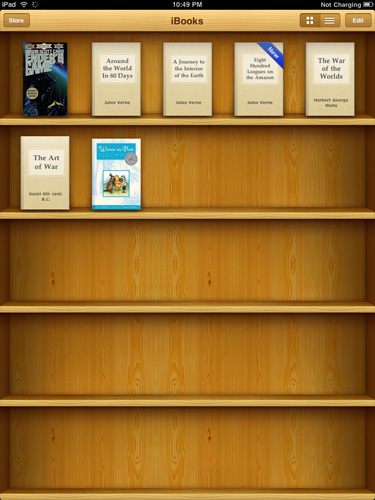
I totally put my real books in bookshelves with their front covers facing out, too
Inside, Apple has crafted a virtual book layout complete with some flashy 3D page turning animations. There's even transparency on the backsides of pages when viewing them in portrait mode.
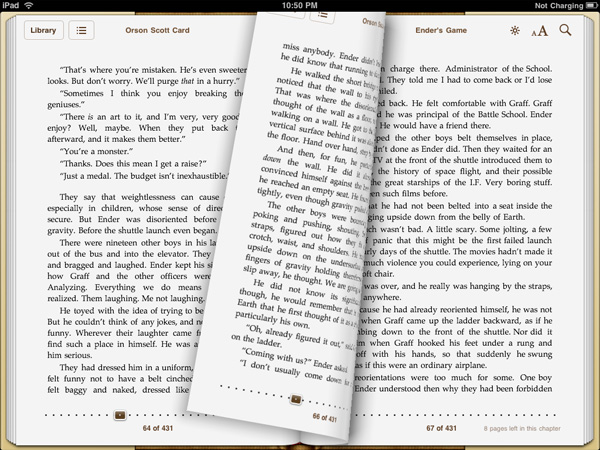
Ooh look at the flashy page turn animations
Controls for brightness, text size, and search adorn the top corner, and a slider at the bottom lets you quickly scrub through the book. You can't flick pages quite as fast as you can in a real book, but it's decently fast. Tapping on words in the body of the text brings up the normal copy dialog, but there's also dictionary, bookmark, and search. Bookmarking puts a faux highlighter mark on the selection, and makes a bookmark. Dictionary pops up an OS X dictionary widget-like popover with the word's definition. Search, well, searches.
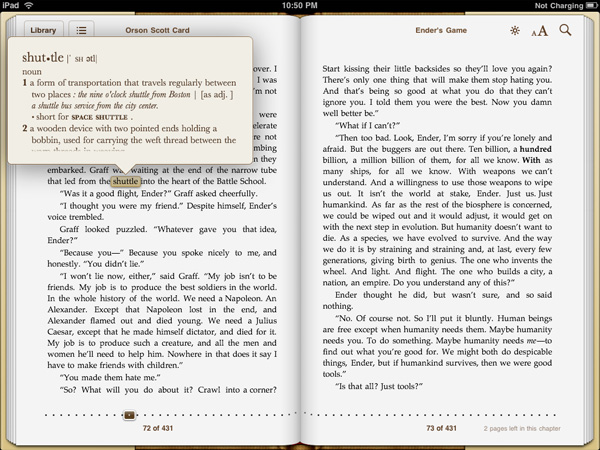
I regularly ride my space shuttle to Boston, er, what?
The store itself is relatively limited in scope this far - searching through it for many of the classics I love revealed that they weren't yet included. Free books from Project GutenbergOrganization and appearance is just like the App Store, except with books. That means ratings, categories and featured are all there as well. The reviews themselves are still getting fleshed out; it's a bit unnerving to see one star ratings on timeless classics, but all of that same goodness from the App Store is here in the book store. Nominal price seems to be somewhere around $9.99, though prices are bracketed by the occasional $14.99 or $8.99 book.
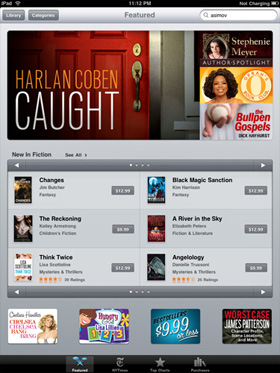 |
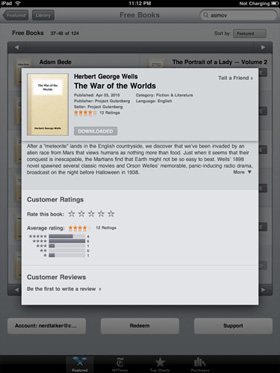 |
Books sync back to iTunes, but you can't open them. In addition, it's apparent that the book store is segmented from the App store somehow, as you cannot buy books in iTunes from the iTunes Store and load them on the iPad. The iBook application fully supports the ePub format for books as well.
Other Reading Apps
If reading through iBooks isn't your thing, there are other ways of consuming print media on the iPad, but for those, you'll have to go install an app.
Case in point are PDFs; if left to using the OS' PDF reader, your only options are either browsing online or as email attachments, and both of those get old fast. Though the default reader works, its typical Apple minimalist style leaves out just about everything that makes modern PDF readers, modern. You can view the document; that's it. If you're serious about reading PDFs, one of the best applications for the iPhone was GoodReader, and its developers launched an iPad compatible version day one. Layout is essentially the same as it was on the iPhone version, just larger and more readable.
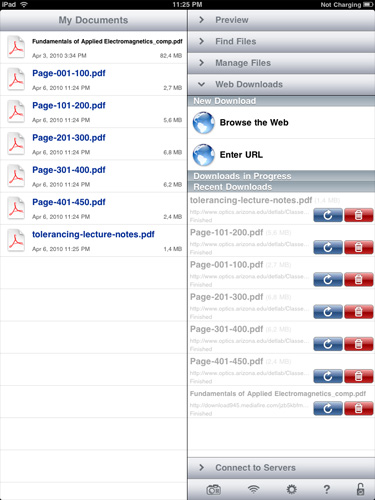
PDFs and Text files can either downloaded from the web or email, or loaded over WiFi, WebDAV, Google Docs, Dropbox or FTP, and are then stored locally. In addition to being noticeably faster than the OS' PDF viewer, there's also an interface complete with bookmarks, search, view, reflow, and even auto scrolling. If you've already got an expansive library of books or notes in PDF form, this is the optimal way to view them for now.
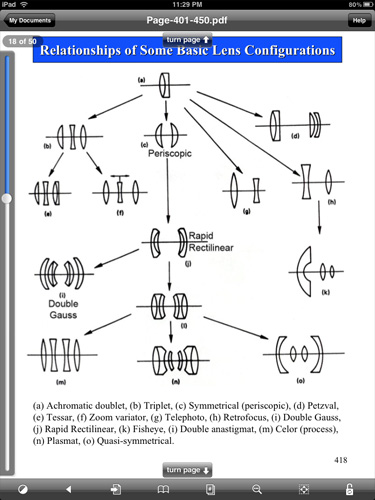
For students, the majority of material is passed down in PDF form; it's nice to finally see a polished document reader for one of the most veteran document formats. In practice, this is the way that iPhone OS' PDF reader should work out of the box.
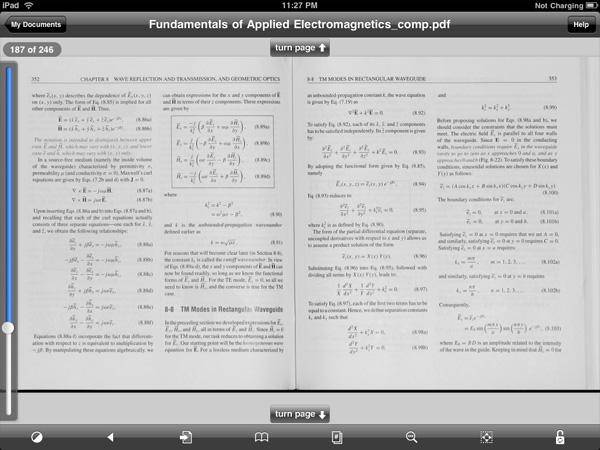
Of course, there's also the Kindle app which has adopted a similar style to the iBooks app, complete with animated 3D page turns, a grid layout, and the like. It's a great utility if you're already invested in a virtual library of Kindle books. If you haven't seen it by now, there's also the Marvel comic book reader. The iPad's usefulness as a book and print media reader is still evolving, but the primary players are still News.
Media - News
The iPad has become something of a messiah for mainstream print media hoping to finally offer a brave new business model for media consumption. Basically all the major press has their own dedicated newsreader or news-zine application, and this is simultaneously great, and destructive for the platform. On one hand, the iPad is a unique way to consume media tailored to a common device form factor - it's no coincidence that the thing is roughly the size of a magazine. On the other, each of the experiences media venues offer is radically different. One thing is for certain, it's unclear what users will ultimately prefer - tailored experiences delivered through venue-specific applications, or simply getting the same content online.
Of course, there are strings attached in the form of subscriptions. There are two ends of the spectrum here - one offers free media, the other is a subscription or issue based model for all your reading habits. Applications like NPR, Bloomberg, BBC News, NYT, Reuters, USA Today and the Associated Press all offer AD-subsidized or essentially free media consumption. There's the occasional inline or application launch advertisement, but most of it is relatively unobtrusive.
Wall Street Journal, Time, GQ and others instead only offer in-application subscription or purchase. Will people consume media and tolerate the occasional AD, or is subscription the only way to monetize the iPad? The subscription model battle that some media venues are hoping will save their publications will likely be fought partly on the iPad and other converged distribution platforms.
Utility, Entertainment and Social Media
At least thus far, it seems as though a lot of applications have taken a nod from Apple's Mail application design - a quarter width tab at left with information, and a dominant panel for more focus at right. It's obvious that developers used to working on the relatively cramped layout of the iPhone still haven't found the optimal use layout for the iPad's larger screen, but this two panel approach nearly mitigates lack of multitasking for some use scenarios.
The best of example of which is side by side Twitter with web browsing. If any of you are like me, you likely browse with a Twitter client open on one side of the screen and a browser on the other - offering you a glance at what's going on alongside the program in which to view it. This is exactly what TweetBrowser offers, and I think it's the kind of new use scenario that will distinguish the iPad from its smartphone brethren. In time, we'll likely see more efficient use of screen real-estate in other applications, which TweetBrowser does already.

TweetBrowser - Best of all, it's free
Another awesome use of the newfound real-estate is in TweetDeck for iPad. Landscape mode offers a view of all your default tabs and searches, while portrait mode lets uses the vacant space at top to display tweets in detail view, or a browser for links.



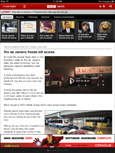
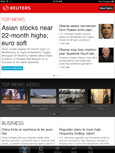










108 Comments
View All Comments
dagamer34 - Friday, April 9, 2010 - link
Anyone who looks at the raw costs of materials and bases decisions of a product being "overpriced" has never taken Business 101.I'll limit myself to 4 things which that "50-60%" pays for:
1) Running Apple stores and employees
2) Running Apple itself in Cupertino (and worldwide) - employees, board, executives, etc.
3) Apple product support for the first year (phone support, in-person support, etc.)
4) Warranties (i.e. - your iPad breaks in the first year and you complain they should fix it on their dime)
NEVER assume a company gets a "huge" profit when only looking at BOM. That's just idiotic. And it's almost impossible to know how much the points I listed above factor into a product's cost in any great detail without making huge assumptions or pure guesswork.
manicfreak - Friday, April 9, 2010 - link
Doesn't change the fact the profit gained from the iPad is higher than the iPod from the last few years.Overpriced.
GTaudiophile - Thursday, April 8, 2010 - link
That is indeed one of the best episodes of TOP GEAR ever.And then at the end, they all drive home to Sigur Ros playing in the background.
semo - Thursday, April 8, 2010 - link
"There's also an optional VGA output, but I won't point out what issues I have with that."Why?
Anand Lal Shimpi - Thursday, April 8, 2010 - link
I was poking fun at it, I thought it was obvious what my issues with a VGA dongle would be. Especially given that Apple's own products haven't supported VGA in years, and the input is definitely not common on modern HDTVs.It looks like the iPad is missing a TMDS as we don't get any options for digital out (HDMI, DVI, DP). I'll clarify in the article :)
Take care,
Anand
PhilipHa - Thursday, April 8, 2010 - link
You may be interested inhttp://www.brightsideofnews.com/news/2010/4/7/the-...
contains some interesting performance comparisons between x86 and ARM (but not IPAD)
pervisanathema - Thursday, April 8, 2010 - link
You would be much wiser to wait for the inevitable widescreen version with a camera and faster CPU. I guarantee Apple has one in the works and they are simply waiting to screw the early adopters. The 4:3 aspect ratio was obviously picked solely so they would have a compelling reason to force people to buy the next revision.dagamer34 - Friday, April 9, 2010 - link
OR 4:3 works better with books and it's the same ratio as the iPhone?Shadowmaster625 - Thursday, April 8, 2010 - link
You pick a heck of a time to start complaining about apple's app pricing. Of course they are going to charge an arm and a leg for apps. That's what apple does. That's ALL apple does. This device, all told, requires an over $1500 investment for 2 years.iPad $500
Bag $30
10 Apps $120
2 years of service $720
Other accessories $50
Taxes ~$100
Total >$1500
It is a ripoff of epic proportions. It's no faster than a penium III notebook I can buy on ebay for $68. This is outrageous. Are you out of your flippin mind? The real economy is in the middle of a depression. Real private GDP is down close to 20%. By and large, the only people who are going to be able to afford this overpriced garbage are people sucking off the government teat. (Like union trash collectors and station agents who make 6 figure salaries.) Nobody who actually works for a living in the private sector is going to spend $1500 on something like this, not if they wish to remain solvent anyway.
strikeback03 - Friday, April 9, 2010 - link
Umm, your numbers are slightly off. There is no service fee for the WiFi-only $500 iPad. The 3G version starts at $630.Besides that though, I know plenty of people who have the disposable income to buy a toy like this of they wished. Sure it is overpriced, but just as there are consumers who pay $500 and up for video cards ther are some who pay $600-700 for expensive toys like this. It is arguably a better use of money than that $800 netbook Sony came out with last year.